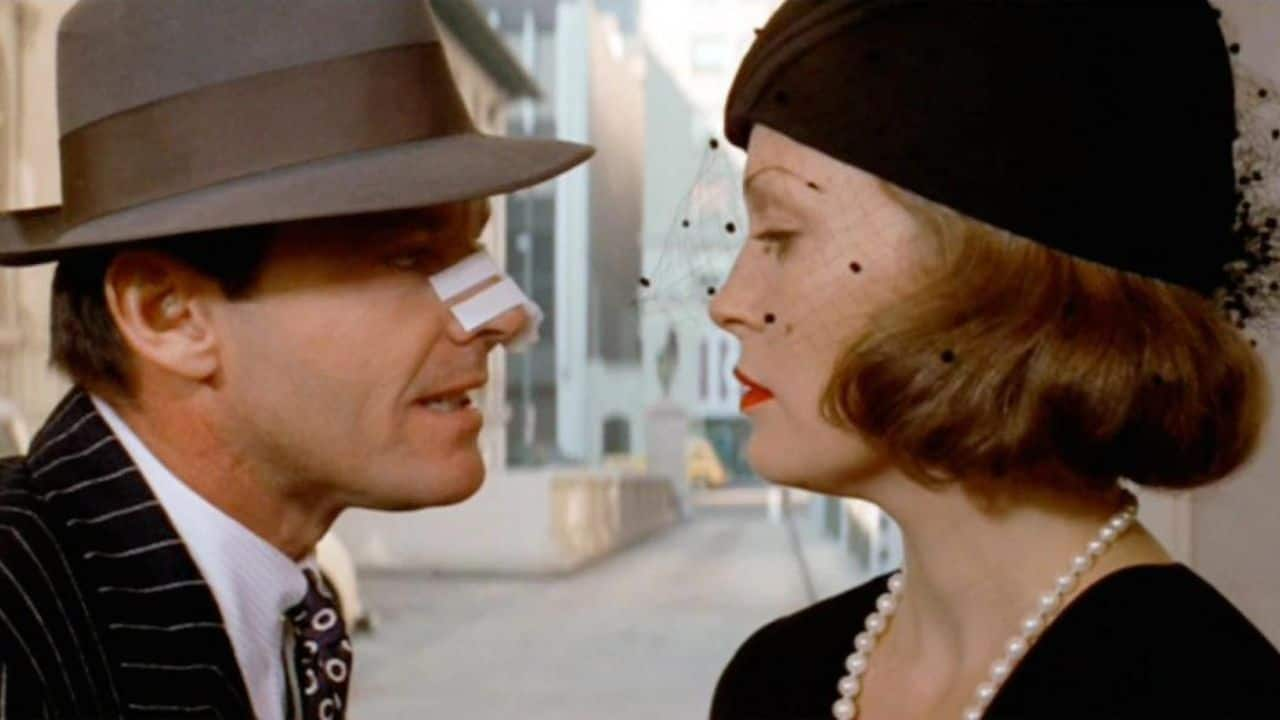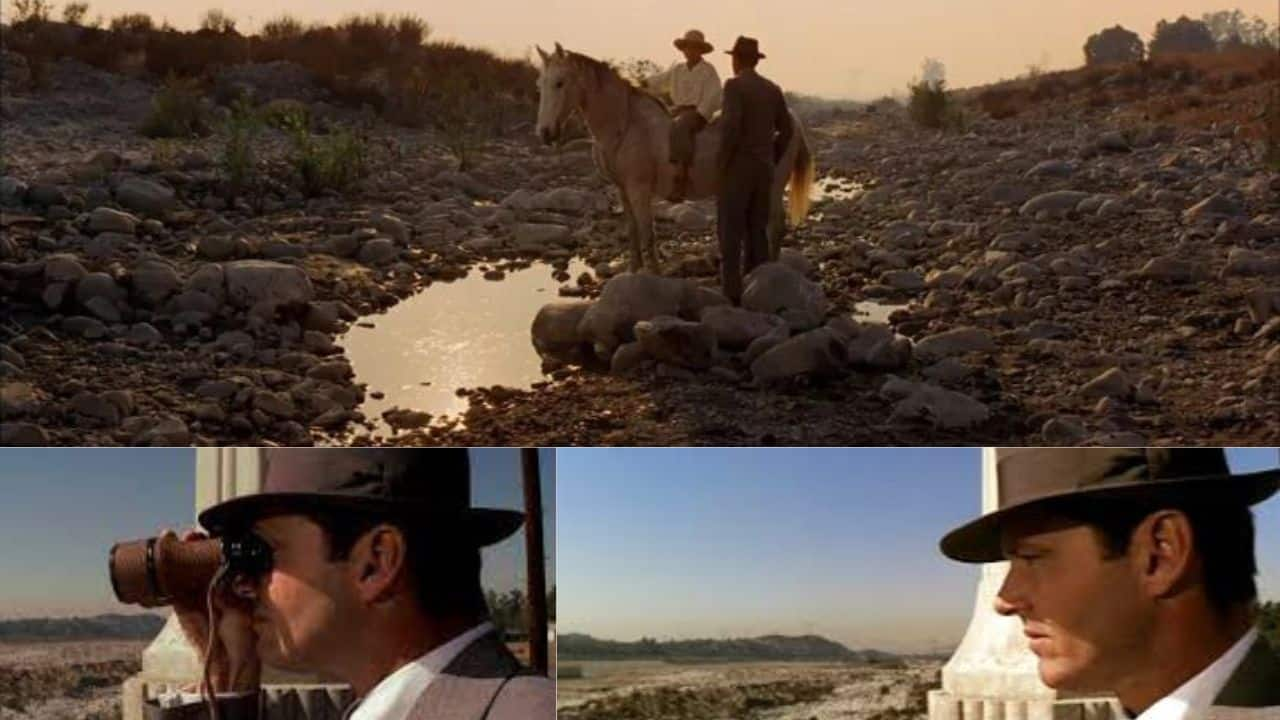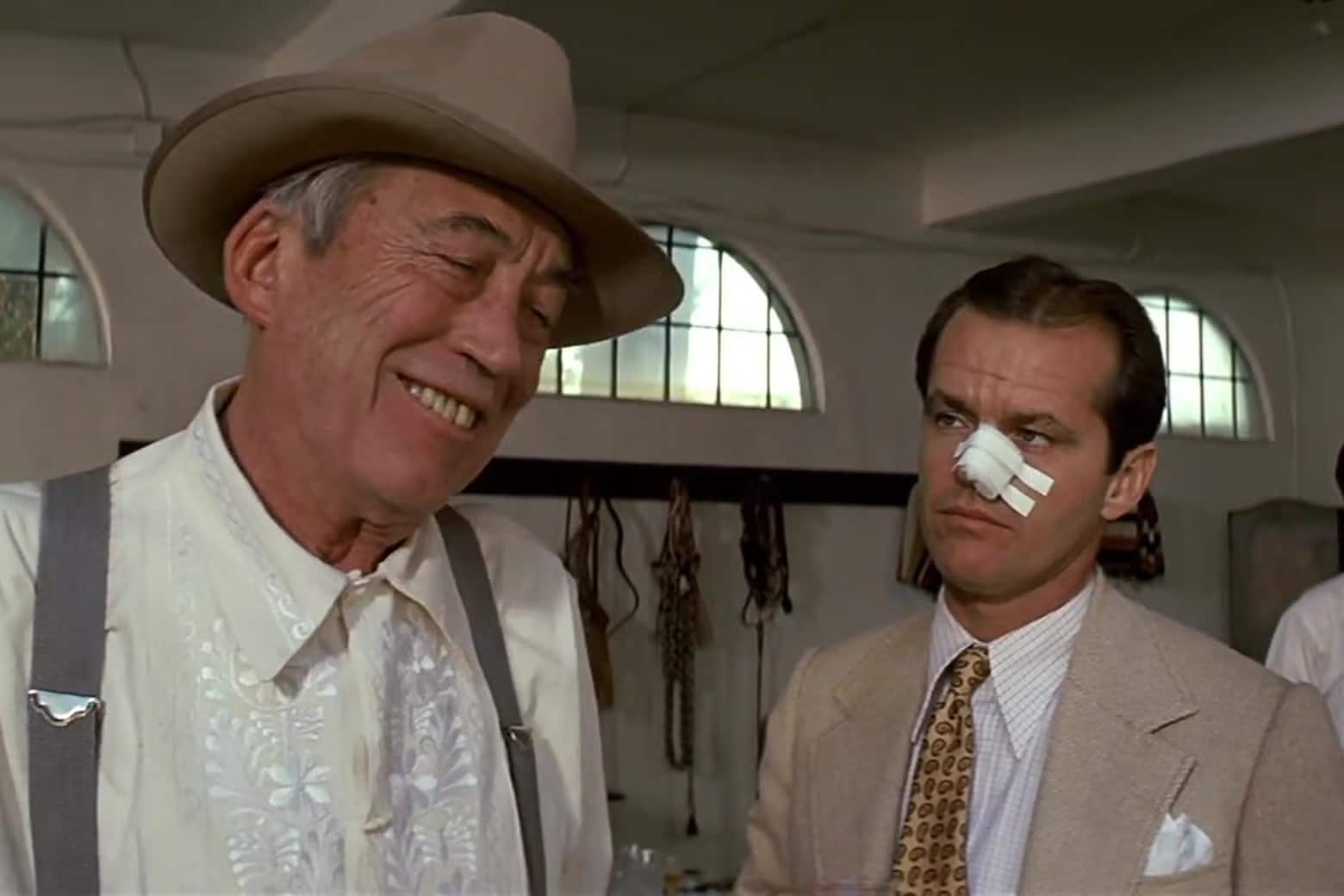



Private eye JJ ‘Jake’ Gittes (Jack Nicholson), whose métier is solving adultery cases, is hired by a woman posing to be the wife of LA Department of Water and Power chief engineer Hollis Mulwray. Gittes trails Mulwray. The real wife Evelyn (Faye Dunaway) visits Gittes. Mulwray is found dead in a reservoir. Mulwray’s powerful father-in-law and former business partner Noah Cross (John Huston) hires Gittes to locate Mulwray’s disappeared mistress. All roads lead Gittes to water, to a scam around the city’s water supply, linked to Cross. Gittes does as little as possible.
 A still from 'Chinatown'.
A still from 'Chinatown'.
Chinatown (1974) turned 50 years last month, screenwriter Robert Towne bit the dust, at 89, days after. Towne won the film’s only Oscar for the Best Original Screenplay in 1975. The film tied for the maximum nominations (11) with Francis Ford Coppola’s The Godfather Part II, which bagged six awards. Interestingly, Towne had worked as a “script doctor” on the first instalment of Coppola’s Godfather (1972). He wrote the garden scene between Vito Corleone (Marlon Brando) and Michael (Al Pacino), the father-son resolution scene didn’t exist in Mario Puzo’s novel.
Towne was working on a Chinatown prequel series for Netflix with filmmaker David Fincher.
Why is Chinatown a cult film?
“Screenwriter Robert Towne and director Roman Polanski, working for the first time with a script not written by him, created a work of art disguised as a commercial movie,” says veteran film critic Saibal Chatterjee.
The watershed movie, which author Sam Wasson calls the last “old Hollywood” film in The Big Goodbye (2020), was a money spinner for Robert Evans’ Paramount Pictures and marked Polanski’s return to Hollywood. The infamous director later fled to Europe to avoid prosecution for raping a minor.
Filmmaker Putul Mahmood, who teaches direction and screenplay writing at Satyajit Ray Film and Television Institute (SRFTI), Kolkata, says, “Chinatown’s screenplay is very fascinating, what they reveal about the society is a very difficult feat. There is greed, adultery, water scandal, murder mystery, and something even more harmful: the abuse of women. At the heart of this film, the abuse of the woman gives the film a new insight, makes it even more impactful.”
“This film has several plot points: false Mrs Mulwray, the adultery, Jake shadowing Mr Mulwray, who doesn’t come across as a womaniser, it turns into a murder mystery, and the real Mrs Mulwray is not interested in finding out who killed her husband… The events in the story totally flips the direction the film is going in. You cannot start to predict, it keeps you gripped and guessing, and so the film doesn’t feel dated at all. In thrillers, these kind of plot points or subplots, coming at this kind of frequency, makes the viewing compelling,” she adds.
What’s also fascinating is that Chinatown invokes the American popular genre of the hard-boiled detective story, including the “hard-boiled” setting of Los Angeles in the 1930s, as seen in Dashiell Hammett’s and Raymond Chandler’s novels, which influenced noir films. “Chinatown and its sleuth protagonist, in turn, mirrored two classic 1940s film noir dramas, The Big Sleep and The Maltese Falcon (directed by John Huston, who plays Noah Cross in Polanki’s film), starring Humphrey Bogart as Philip Marlowe in the former and Sam Spade in the latter,” says Chatterjee. In their appearance and attire, Nicholson’s in his career-best role as JJ Gittes and Dunaway’s Evelyn Mulwray remind of Bogart and Lauren Bacall from the classic noir films.
 Jack Nicholson and Faye Dunaway in a still from 'Chinatown'.
Jack Nicholson and Faye Dunaway in a still from 'Chinatown'.
“Chinatown set the template for neo-noir thrillers across the world by bringing a contemporary sensibility to bear upon a genre born in the 1930s-40s Hollywood golden era. It achieved an incredible balancing act: it mixed post-Depression era concerns centred on greed and corruption with a style firmly rooted in the 1970s,” adds Chatterjee, “Chinatown influenced films like Who Framed Roger Rabbit (1988) and L.A. Confidential (1997) besides, of course, its not-so-successful sequel The Two Jakes (1990).”
Towne had planned a trilogy of 20th century Los Angeles corruption: Water in Chinatown, oil in Two Jakes, directed by Nicholson, and land in the shelved Gittes vs Gittes.
 A still from 'Chinatown'.
A still from 'Chinatown'.
If Jerry Goldsmith gives the movie its iconic, haunting background score, “John Alonzo’s colour cinematography [including rich golden light in the dry riverbed scene] was strikingly informed with the feel of a black and white noir work,” says Chatterjee.
How to read Chinatown
Studied for its taut screenplay and three-act structure in film schools, Mahmood, an FTII alumna who teaches at SRFTI, says, “Every session that I teach, I include Chinatown.”
“The neo-noir film, made in the mid ’70s, is a layered thriller. The water scandals of 1930s LA, California was the subtext for Chinatown. Then the story becomes a detective thriller and then a murder mystery,” she says. Hollis Mulwray is sketched on the real-life William Mulholland who made the Los Angeles Aqueduct, diverting water from the Owens Valley farming communities to the desert that was Los Angeles.
“Film noir emerged in postwar ’40s-’50s and was influenced by German Expressionist movement. With the coming of Hitler, many people from Germany migrated to Hollywood/America and brought with them these art influences. In the early 20th century, both Europe and the US were going through a dark period. The sociopolitical climate was dark, there was hopelessness, the [Great] Depression took place, in that environment, very dark cinema was born,” says Mahmood, “And Polanski’s own past is extremely dark. His parents were killed in the Holocaust… he’s a victim of violence and was later accused of violence [raping a minor].”
Chinatown: Misogyny, patriarchy and abuse of women
When Mahmood shows the pivotal scene in class — Evelyn’s pained outburst: “She’s my sister. She’s my daughter. She’s my sister and my daughter” — some students tend to laugh because they find Evelyn absurd. Evelyn is slapped by Gittes; Gittes finds spectacles in the garden pool and accuses her of murder; later, he calls the police to give her away; and even after finding her truth, he unwittingly lands her in danger.
 John Huston (left) and Jack Nicholson in a still from 'Chinatown'.
John Huston (left) and Jack Nicholson in a still from 'Chinatown'.
“Chinatown brings out the whole patriarchal culture, where this guy (Noah Cross) gets away with his actions. It is the rich, corrupt and evil who wins. The hero is a loser hero [with a burlesque imagery of a big, bandaged nose, for being too ‘nosey’] who has to suffer…loss. And women are prey to the world of men [Evelyn, Katherine]. Even love betrays Evelyn, who’s a spin on the femme fatale, interestingly written and depicted. The whole track becomes about her betrayal. An essential noir component is the archetypal seductress who’s going to betray you. But in Chinatown, Evelyn doesn’t betray Jake, he betrays her, his involvement leads to tragedy, for all his goodness, he has that one fatal flaw. It is part of his patriarchal past: one more woman dies in Chinatown, he couldn’t save her. He’s doomed to repeat the same cycle, in Chinatown itself,” adds Mahmood.
Polanski made Towne return to Chinatown, against his will, and change the “upbeat” ending to a bleak, horrific, nihilistic one. Chinatown is where it isn’t clear whether the police help prevent a crime or commit one. Chinatown, as Towne had told Evans, “is not a place but a state of mind”, it’s a metaphor for the futility of good intentions.
Did Chinatown influence these Indian films?
“Noir, by its very nature, is a Western form. Teesri Manzil (1966) is a masterly use of noir in Hindi cinema (Bombay noir),” says Mahmood, “In India, the hybrid neo-noir were musicals earlier, with beautifully choreographed long takes and several songs, Helen’s cabarets in Vijay Anand films.” Mahmood calls Kamal Amrohi’s ghost story Mahal (1949), shot by German cinematographer Josef Wirsching, an influence between noir and Expressionist film. And finds Hirokazu Koreeda’s Japanese social Shoplifters (2018) closer to Chinatown, not in terms of genre but “in the way there are so many plot points, and you keep getting newer information about the characters and newer perspectives on their relationships.” Mahmood further notes that the “male hero is not a metric. The neo-noir crime thriller Bound (1996), directed by the Wachowski sisters Lana and Lilly, has she-heroes, a lesbian couple.”
“In India, at least two films, Manorama Six Feet Under (2007) and Raat Akeli Hai (2020), have clear echoes of Chinatown,” says Chatterjee. Critic Uday Bhatia also finds a resonance in Abhishek Chaubey’s dacoit Western Sonchiriya (2019), when Indumati (Bhumi Pednekar) reveals to her fuming son that he’s a product of incest and rape, “He was your grandfather. He was your father” as an echo of Evelyn’s from Chinatown.
 Abhay Deol in a still from 'Manorama Six Feet Under' (2007).
Abhay Deol in a still from 'Manorama Six Feet Under' (2007).
Manorama Six Feet Under director Navdeep Singh says, “When Devika (Bhagat) and I wrote it, we never started off with the intention to adapt Chinatown. It was about a doctor who knows his patient is dying and uses that to his own advantage. Then came the story of a junior engineer. We decided to adapt some of those [Chinatown] elements. Devika kept the two goons bit [Polanski slicing Nicholson’s JJ Gittes’ nose becomes two goons breaking Abhay Deol’s Satyaveer’s fingers]. Manorama (Sarika), the lady coming for help to [author-turned-detective] Satyaveer is a noirish trope. If you are making a traditional noir film, it’s difficult to escape Chinatown’s elements, which is basically the noir tropes,” says Navdeep, who plays a scene from Polanski’s film on television in his own film.
Manorama… came out the same year Sriram Raghavan released Johnny Gaddaar which, Mahmood says, “is right up there among Indian noirs.” “Johnny Gaddaar is the best noir film in India,” says Smita Singh, the co-writer of Sacred Games (2018) and writer of Raat Akeli Hai (2020), “In the film, every character Raghavan builds has empathy. Ek Hasina Thi (2004) is also fantastic, the way he builds Urmila’s (Matondkar) character is unsettling, it uses the same trope of romance.”
Manorama… went into production with Irrfan but that was not to be. Later, despite telling off a persistent Abhay Deol that he’s too young for the role Navdeep acquiesced and told him “to grow a moustache and a tan”.
“I love Manorama… for its treatment of Rajasthan; it is closer to Chinatown unlike Raat Akeli Hai,” says Smita.
Navdeep, however, lists the “big departures from Chinatown” in Manorama…, “the larger Rajasthan context is different. The Sheetal (Raima Sen) character is entirely different. Detective having a family is also different from Polanski’s film and from classic noir. There are other cinematic references and Easter eggs in the film. For instance, [Robert Aldrich’s] Kiss Me Deadly (1955).” Navdeep is a big Polanski fan, especially of early Polanski, he says, and how “he manages to layer and sustain the thematic core of his story, of what he’s telling, by and large. He’s also great at creating tension, like in his first film Knife in the Water (1962).”
Not inspired
“The formation of Los Angeles, the downbeat, deep corruption, power and greed as the bedrock of LA makes Chinatown. If Raat Akeli Hai is a tribute, it is to the noir genre, to ’80s Hindi films, and Vijay Anand, there’s a tribute to Teesri Manzil,” says Smita. If the film’s title is inspired from Anand’s Jewel Thief (1967) song, a scene with a pearl torn from a dupatta is reminiscent of a pricey coat button retrieved from the crime scene in Teesri Manzil.
 Nawazuddin Siddiqui in a still from 'Raat Akeli Hai' (2020)." width="1000" height="531" /> Radhika Apte and Nawazuddin Siddiqui in a still from 'Raat Akeli Hai' (2020).
Nawazuddin Siddiqui in a still from 'Raat Akeli Hai' (2020)." width="1000" height="531" /> Radhika Apte and Nawazuddin Siddiqui in a still from 'Raat Akeli Hai' (2020).
Set in Kanpur and directed by Honey Trehan, Raat… “shows a patriarchal society operational through a joint family, where women can’t talk about oppression. The weakest will get exploited. (The house helps) Chunni and Kalavati literally have no voice — through them, I wanted a revenge of the subaltern,” says Smita, “Corruption comes into the family, there is no place to hide. There is repressed sexuality and dark secrets in the family.” Raghuveer raping his niece echoes Noah Cross raping his daughter Evelyn. “Incest is a very strange and real problem in joint families in the Indian subcontinent,” she adds.
In Raat… Smita subverts the idea of femme fatale. “I initially wrote the story from Radha’s (Radhika Apte) perspective but changed it to Jatil Yadav’s (Nawazuddin Siddiqui) to make the plot darker and show the anxiety that men have, the male gaze has, of women’s sexuality as powerful and dangerous,” she says, “The politician is a Thakur/Zamindar while the cop is a non-elite-caste man, who goes into the family/house of the upper-caste. Where do you have a Yadav as a cop [in Bollywood films]? In the Indian context, we can do so much more.”
Unlike the morally ambiguous Gittes, Jatil Yadav is a self-righteous cop, “not inspired from hardboiled heroes… doesn’t have charm, is dependent on a parent, is non-elite… I wanted to bring Salman Khan’s Dabangg-like dialogues for the working class. We had Nawaz in mind for the cop’s role. The state of this racist film industry (Bollywood) is such that dark-skinned actors are uncommon,” Smita adds, “Jatil is an adult man living with his mother and cursing her for not finding him a suitable bride, he’s a vulnerable man, very different from a Western person. In terms of adaptation, a cop falling in love with the woman makes Raat Akeli Hai closer to L.A. Confidential than to Chinatown.”
Smita was deeply hurt when Raat Akeli Hai was called a copy of Knives Out (2019). She had written the first draft at Film and Television Institute of India (FTII) in 2014-15, when Anurag Kashyap had read it and wanted to make the film. It was sold in 2016. The writer planned Raat Akeli Hai as a trilogy. The second film might come soon, a new case with the same cast.
 Girish Kulkarni and Sai Tamhankar in a still from Marathi film 'Pune 52' (2013).
Girish Kulkarni and Sai Tamhankar in a still from Marathi film 'Pune 52' (2013).
Marathi filmmaker Nikhil Mahajan also curses the internet for misleading the world. His neo-noir drama Pune 52 (2013) is not “loosely” based on Chinatown, “not even remotely. It has a detective on hire who clicks photographs of adultery. The similarities end there. It is a neo-noir film with elements of a husband-and-wife drama and the story of an out-of-business detective. There are, of course, neo-noir elements: flawed detective, unhappy wife, femme fatale,” he says.
The title, Pune 52, is the pin code of the Karvenagar area, on the outskirts of Pune. “With 1992’s modernisation/liberalisation, people from old Pune started shifting to this part of the city, the film talks about upheaval of the middle class, who are on the cusp of a drastic change, and uses the detective as somebody operating in the shadows,” adds Mahajan, who won the National Award for Godavari in 2023 and whose next will be the environmental thriller Raavsaheb.
He notes, “Sriram Raghavan uses noir tropes greatly. Malayalam and Tamil films use neo-noir. [Super Deluxe director] Thiagarajan Kumararaja’s [debut Tamil gangster film] Aaranya Kaandam (2010) is an underrated classic neo-noir. Anurag Kashyap’s Ugly (2013) has noir elements as does [Vikramaditya] Motwane’s superhero film Bhavesh Joshi Superhero (2018) and Vasan Bala’s Monica, O My Darling (2022).”
Forget it…it’s Chinatown
 A still from 'Chinatown'.
A still from 'Chinatown'.
“But, yes, a Chinatown is a once-in-a-lifetime film,” says Navdeep, “Why a film like that survives for a long time is because its specific historical context gives it a lot of flavour. The essential story of moral corruption and the larger issue of how complicit we are all in our silence resonates across eras and the film stays relevant.” Smita adds, “A story/film has to be layered otherwise a dry plot won’t hold out. For a noir film to survive, it must have intelligence and empathy. Minus these, whatever you make will be empty. There’s humour, intelligence and empathy in [Sriram] Raghavan’s oeuvre. There are many whodunnits and whydunnits in India now but not as many noirs.”
Chinatown, one of the great screenplays ever to be written, is one of those rare films I wish I could return to for the first time every time.
Discover the latest Business News, Sensex, and Nifty updates. Obtain Personal Finance insights, tax queries, and expert opinions on Moneycontrol or download the Moneycontrol App to stay updated!
Find the best of Al News in one place, specially curated for you every weekend.
Stay on top of the latest tech trends and biggest startup news.